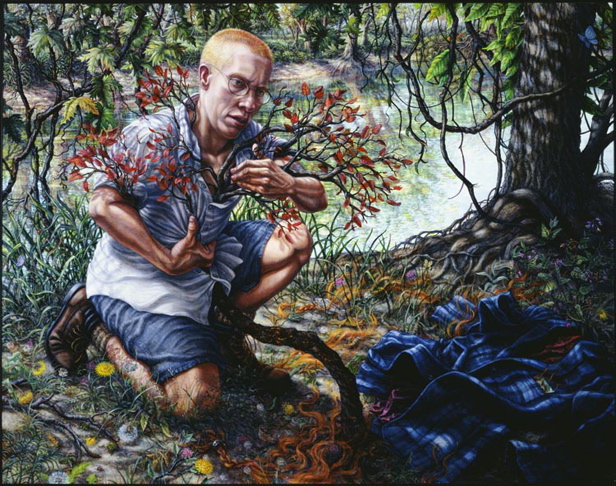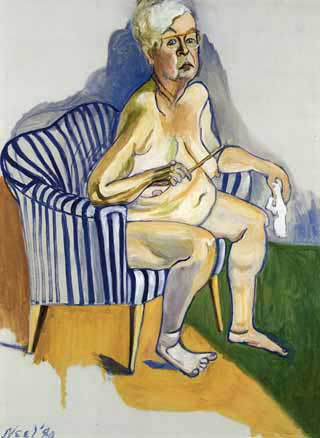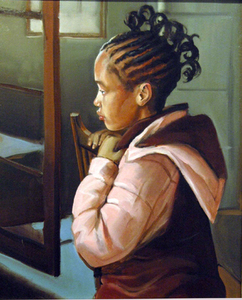August 18, 2014 - 15:19

DISABILITY, IDENTITY, CULTURE
 |  |  |  |
Riva Lehrer's Portrait of Eli Clare, Alice Neel's Self Portrait, Nancy Bea Miller's Amber Dreaming, and Guo Ixo's Early Spring
HLTH/ICPR 207 Prof. Kristin Lindgren
Fall 2014 Stokes 118 IA
M-W 2:30-4 klindgre@haverford.edu
Stokes 119 610-220-3670
COURSE DESCRIPTION
In this course, we will explore representations of illness and disability in literature, culture, and visual art and examine how these representations put pressure on theories of identity, identity studies, and post-identity politics. Discussing medical, social, and cultural models of disability, we will consider how each model foregrounds different aspects of disability experience and different concepts of identity. We will ask: Who gets to tell stories and create images representing ill and disabled bodies and minds, and what ethical conundrums are involved in this work of storytelling and image-making? How might ethical practices of storytelling and portraiture enlarge cultural and aesthetic views of embodiment, disability, and difference? How do embodied identities of race, gender and sexuality, class, and ability intersect and collide? How do bioethical dilemmas construct the category of ‘disability’?
COURSE EXPECTATIONS
Students will contribute weekly postings to Serendip (due Sundays by 5 PM) complete two 5-7 page essays and a final multi-course project and portfolio, and participate in workshops with our artist-in-residence and 360 events and field trips.
Students who think they may need accommodations in this course because of a disability are encouraged to meet with me early in the semester. Students may also contact The Office of Disability Services to verify their eligibility for accommodations.
REQUIRED TEXTS:
Eli Clare, Exile and Pride: Disability, Queerness and Liberation. Available in Bryn
Mawr Bookstore.
Susan Nussbaum, Good Kings, Bad Kings: A Novel. Available in Haverford Bookstore.
Lennard J. Davis, ed. The Disability Studies Reader, Fourth Edition. Available
in Haverford bookstore; print and e-book on reserve in Magill Library.
Other course readings will be available as pdfs and films will be on reserve and/or
available through Netflix or other sources.
WEEK ONE: THE PROBLEM OF IDENTITY
Wednesday September 3
Introductions
Andrew Solomon, Far From the Tree, pages 1-6
Make identity graphs
Sunday September 7 by 5 PM
Post on Serendip a reflection (ideas, questions, conundrums, close readings) on the reading for Monday. We will build our conversation Monday around these reflections.
WEEK TWO: INTERSECTIONS
Monday September 8
Eli Clare, Exile and Pride: Disability, Queerness, and Liberation
We will pay particular attention to "the mountain" and Part ii: bodies, "freaks and queers" and "reading across the grain"
Reread Solomon excerpt and bring to class revised identity graphs/models
Wednesday September 10
Discuss revised identity graphs/models
Continue discussing Exile and Pride
Tobin Siebers, “Disability and the Theory of Complex Embodiment-For Identity Politics in a New Register,” in DSR
Viewing: www.rivalehrerart.com especially Circle Stories and Self-Portraits
WEEKS THREE AND FOUR: PORTRAITURE AND ANTI-PORTRAITURE
Sunday, September 14
Post on Serendip, by Sunday at 5, an image (ad, photo, film or video clip, etc) depicting or implying disability, and a written reflection on this image. Look for an image that either takes an interesting/unusual approach or calls for critique. Video clips should be one minute or less. If you wish, you may draw on or challenge RGT's visual rhetorics of disability in discussing your image or clip.
Monday September 15
Viewing: www.rivalehrerart.com especially Circle Stories and Self-Portraits
Reading: Rosemarie Garland-Thomson, “The Politics of Staring: Visual Rhetorics of
Disability in Popular Photography”
In-class Talk and Slideshow on Disability Arts and Culture, "Strategies of Vision: Artists, Impairment, and Disability Culture" with Mellon Creative Resident Riva Lehrer
Wednesday September 17
In class: Perceptual Drawing project with Riva Lehrer
Thursday September 18
Reading: Michael Bérubé, Epilogue: Life As We Know It
G. Thomas Couser, “Auto/Biographical, Biomedical, and Ethnographic Ethics,” from
Vulnerable Subjects: Ethics and Life Writing (in reading file for Kristin's class)
Meet together with Anne Dalke’s class for a discussion of ethical portraiture, ethical storytelling, and informed consent, facilitated by Riva
Friday September 19
Field trip to Camphill Village, site of our fall break project
Vans leave Bryn Mawr at 12, return at 4
Sunday September 21
Post on Serendip, by Sunday at 5, either a reflection on some aspect of Riva's visit, a response to one of the images or clips your classmates posted last week, or a reflection on the reading for Monday. What do visual images of our bodies, or of disabled bodies in particular, DO?
Monday September 22
Reading: Rosemarie Garland-Thomson, “Picturing People with Disabilities: Classical
Portraiture as Reconstructive Narrative,” in Re-Presenting Disability: Activism
and Agency in the Museum
We'll also spend some time looking back at the images and clips you posted last week.
Wednesday September 24
Reading: Harriet McBryde Johnson, “Art Object,” in Too Late to Die Young
Riva Lehrer, “Beauty in Exile”
Viewing: Portraits by Riva Lehrer, Laura Swanson, Doug Auld, Nancy Bea Miller, and others
WEEK FIVE: SIGHT UNSEEN; NAMING DISABILITY
Monday September 29
Reading: Georgina Kleege,“Introduction,” “The Mind’s Eye,” and “A Portrait of the Artist by His Blind Daughter” from Sight Unseen
Tuesday September 30
Talk: Moon Reader exhibition and artist's talk, 4:30-5:30, Magill Library
http://www.haverford.edu/calendar/details/261932
Post on Serendip, by Tuesday at 10 PM, a close reading of a portrait.
Choose a portrait or self-portrait of someone with a visible disability: one of Riva’s portraits, a portrait by one of the artists Riva or Rosemarie Garland-Thomson discussed, or one you find on your own. Spend some time looking at the portrait, first simply taking it in visually and then taking notes on what you see. Once you’ve had sufficient time to view the portrait, write a descriptive close reading of it, including Garland-Thomson’s categories of frame, pose, and costume. Also comment on the composition, color, and medium (oil? acrylic? charcoal?), the gaze of the portrait’s subject (directly gazing at the viewer? gazing at an object within the portrait? off into the distance?) and the background. If the portrait’s subject is identified, tell us who it is. You do not need to make an argument, construct a thesis, or do research. Nonetheless, your visual observations may lead you to pose some questions or offer some initial ideas about how the details of the portrait might be interpreted.
Some possible sources for portraits and self-portraits:
Riva Lehrer's Circle Stories and other portraits
Laura Swanson's Anti-Self-Portraits
Beverly McIver's portraits of her sister Renee and others
http://cravenallengallery.com/artists/beverly-mciver/
Doug Auld's States of Grace
Nina Berman's Purple Hearts
http://www.ninaberman.com/purple-hearts
Chris Rush: 17 portraits
http://www.chrisrushartist.com/html/portraits.html
Wednesday October 1
Georgina Kleege, "Voices in My Head" and "Up Close, In Touch" from Sight Unseen.
WEEK SIX: REPRESENTING INTELLECTUAL DISABILITY
Sunday October 5
Post on Serendip, by Sunday at 5 PM, a reflection on some aspect of the film Monica and David and its representation of intellectual disability.
Monday October 6
Viewing: Alexandra Codina, director, documentary film Monica and David (Available through Netflix, Amazon, and other sites. I tried to put it on reserve at Magill Library, but their copy of the film seems to be lost. . . they're looking for it.)
Wednesday October 8
Before class: post the portraits you're writing about on Serendip so you can show them in class (you can add your completed essay later).
Discuss nearly-completed essays in class. 5-6 minutes each: show the portraits you're writing about, articulate some of your ideas about them, describe something you're still trying to figure out. We'll have to stick closely to the allotted time to make sure everyone has a chance to talk about their project.
5-7 page essay due by midnight
In this essay, you will construct an argument/interpretation based on a close reading of two or three portraits. You may write about the portrait you have already explored or you may choose new ones. You must provide some rationale for your grouping: for example, you could write about portraits in the same series or portraits that you want to compare or contrast in some specific way.
Some questions you might consider: What social, cultural, or institutional work are these portraits doing? Through what aesthetic strategies (here’s where your close reading comes in) does it accomplish this work? How do these portraits reinforce, question, or challenge our expectations of portraiture?
You will draw on close readings of your portraits as evidence to support your argument, but you do not necessarily need to include all of the details you noted in your earlier close reading. You want to give your reader a sense of the portrait as a whole, but you also want to focus on the particular aesthetic strategies (whether they have to do with framing, costume, color, expression, pose, or something else) that are most relevant to your argument.
FALL BREAK
Sunday, October 13 to Thursday, October 17
Bring to Camphill: a realistic(ish) self-portrait you have drawn, a list of ten "pleasure-centered" questions that you might ask a Camphill villager, AND YOUR ART SUPPLIES!
Trip with the 360 cluster to Camphill Village in Kimberton, PA, an intentional community that includes adults with intellectual disabilities. Drawing on our conversations about ethical portraiture and storytelling and with Riva Lehrer’s guidance, we will create portraits of Camphill villagers.
WEEK SEVEN: INTERSECTIONS
No Sunday posting this week.
We will not meet on Monday, and we will attend a talk by Anne Balay on Wednesday, but sometime over the course of the week I'd like you to read these pieces that put disability in conversation with other identity categories.
Alison Kafer, "Time for Disability Studies and a Future for Crips," from Feminist, Queer, Crip (pdf)
"What would it mean to explore disability in time or to articulate "crip time"?
Robert McCruer "Compulsory Able-Bodiedness and Queer/Disabled Existence" in DSR
"The system of compulsory able-bodiedness that produces disability is thoroughly interwoven with the system of compulsory heterosexuality that produces queerness"
Douglas C. Baynton,"Disability and the Justification of Inequality in American History" in DSR
"Disability was a significant factor in the three great citizenship debates of the nineteenth and early twentieth centures: women's suffrage, African American freedom and civil rights, and the restriction of immigration. When categories of citizenship were questioned, challenged, and disrupted, disability was called on to clarify and define who deserved, and who was deservedly excluded from, citizenship."
Ellen Samuels, "My Body, My Closet: Invisible Disability and the Limits of Coming Out" in DSR
"I frame a discussion not only of analogies between queerness and disability but of the specifics of coming out in each context as a person whose bodily appearance does not immediately signal one's own sense of identity."
Post on Serendip by Sunday, Oct. 26 at 5 PM: (You may want to post your comment Friday Oct. 24 since you'll be busy over the weekend with "Two Women Talking.")
Choose one of the essays you read and sum up one of its main arguments. You can quote from the essay, but I want you to be familiar enough with the argument that you can explain it primarily in your own words. Then add a webby comment at least a paragraph long that clarifies, supports, complexifies, challenges, or otherwise responds to the argument you've summarized. You may also choose more than one essay and summarize/respond to related arguments.
Monday October 20
NO CLASS
Wednesday October 22
Talk by Anne Gladys Balay, author of Steel Closets: Voices of Gay, Lesbian, and Transgender Steelworkers.
2:30-4, Chase Auditorium, Haverford.
Friday October 24
7 PM: Performance: Monsoon Bissell and Benaifer Bhadha, “Two Women Talking,” Goodhart Music room
Saturday October 25
10 AM to 5 PM: Workshop with Monsoon and Benaifer on the “narrativ” method, Dalton 1 and 2.
Post on Serendip by Sunday, Oct. 26 at 5 PM: (You may want to post your comment Friday Oct. 24 since you'll be busy over the weekend with "Two Women Talking.")
Choose one of the essays you read this week and sum up one of its main arguments. You can quote from the essay but I want you to be familiar enough with the argument that you can explain it primarily in your own words. Then add a webby comment at least a paragraph long that clarifies, supports, complexifies, challenges, or otherwise responds to the argument you've summarized. You may also choose more than one essay and summarize/respond to related arguments.
WEEK EIGHT: INTERSECTIONS AND NONVISIBLE IDENTITIES
Monday October 27
Discuss the four articles you read last week and how each one approaches intersectional identities
Wednesday October 29
Continue discussion of articles you read for Monday and of intersection, analogies, and hierarchies
Catch up with Serendip postings
Reading: Margaret Price, "Introduction" from Mad at School: Rhetorics of Mental Disability and Academic Life (pdf)
Katy Waldman,"Patterns and Panels: How Comics Portray Psychological Illness" (link below)
WEEK NINE: BIOETHICS, PERSONHOOD, AND DISABILITY
Sunday November 2
Serendip posting is optional this week. Either post or bring to class some reflections on a particular idea or passage from the readings that you'd like to discuss in class. Your reflections can relate either to the Johnson, Singer, and Walters readings for Monday OR to the Price and Waldman readings for last week, which some of you will be reading for Monday. We'll spend some time on both sets of readings and we'll try to stay more focused on the readings in class.
Monday November 3
Reading: Harriet McBryde Johnson, “Unspeakable Conversations,” in DSR
Peter Singer, “Life and Death Decisions for Disabled Infants,” from Practical Ethics (pdf)
Peter Singer, "Happy Nevertheless" (pdf, 1 page)
Shannon Walters, “Unruly Rhetorics: Disability, Animality, and New Kinship Compositions” (pdf)
And for those of you who didn't read these articles last week:
Margaret Price, "Introduction" from Mad at School: Rhetorics of Mental Disability and Academic Life (pdf)
Katy Waldman, "Patterns and Panels: How Comics Portray Psychological Illness" (link below)
Wednesday November 5
Reading: Nancy Mairs, Waist-High in the World: A Life Among the Nondisabled, four chapters beginning with "Body in Trouble" and ending with "Freeing Choices" (pdf)
Optional: Sophia Isako Wong, "At Home with Down Syndrome and Gender" (pdf)
WEEK TEN: THE CASE OF DEAF CULTURE
Post on Serendip by 5 PM Sunday: a reflection on the film and/or reading for Monday.
Monday November 10
Viewing: Judy Lieff, director, documentary film Deaf Jam
Reading: Andrew Solomon, “Deaf,” in Far From the Tree (pdf)
Wednesday November 12
H. Dirksen-Bauman, “Designing Deaf Babies and the Question of Disability” (pdf)
OPTIONAL: H-Dirksen Bauman and Joseph J. Murray, "Deaf Studies in the 21st Century: "Deaf-Gain" and the future of Human Diversity" in DSR
WEEK ELEVEN: SEEING AND MAKING PORTRAITS
Friday November 14 to Sunday November 16
Students travel independently by train to the Barnes Foundation and/or Philadelphia Museum of Art to view portraits.
By Sunday at 5:
Required: Post on Serendip a proposal for Essay #2. The prompt for the essay is below. In your proposal, start thinking through the questions you want to ask, the concepts or theoretical framework(s) you want to bring to your questions, and the primary sources (at least two) with which you want to engage. Reading your posts will help me prepare to meet with each of you next week to discuss your proposed project.
Optional: Post a brief close reading and reflection on a portrait or series of portraits you saw at the Barnes or PMA. How might this portrait (or series) shape your approach to the self-portrait you'll be working on this week? Does it tell you anything new about the history and practice of portraiture? About how we represent others or represent ourselves? Was there anything that surprised you about the portraits you saw at the Barnes/PMA?
Essay #2, due Thanksgiving week.
Begin with a series of questions you want to ask about some aspect of disability experience or representation. Choose from our readings (or from other related reading) a theoretical approach or concept that will help you to explore your questions. For example, if you want to think more fully about how disability alters time, you can draw on Halberstam's notion of "queer time" and Kafer's notion of "crip time" in the articles we read, and then select a couple of primary sources that allow you to think about crip time in a new way or through a particular lens. The concept doesn't need to come from a theoretical article--literary essays and other genres can also introduce useful concepts. Choose at least two primary sources; your close readings of these sources will help you to develop your argument. Primary sources can include works of visual art, film, works of literary fiction or nonfiction (Clare, Kleege, McBryde Johnson, Mairs, Solomon, etc), interviews, ethnographic observations, or other sources appropriate to a discipline with which you're familiar. Run an idea by me if you're not sure what "counts" as a primary source or primary research. (For example, if you want to think about access, exploring the BMC campus for particular examples of access/universal design or lack thereof could constitute primary research). If you want to write about something related to disability that we haven't talked about much in class, I'd be happy to help you find resources.
So, in sum: A 5-7 page essay that explores any aspect of disability using a key concept or theory and drawing on close readings of at least two primary sources OR on original research in the form of interviews, observations, etc. Post your essay on Serendip sometime during the week of Nov. 24, Friday Nov. 28 at 6 PM at the latest. On Monday, Nov. 24, each of you will talk about your project for 5 minutes in class and solicit questions and suggestions.
Monday November 17
BRING YOUR ART SUPPLIES TO CLASS!
Self-Portrait project with Riva Lehrer
Wednesday November 19
Self-Portrait project with Riva Lehrer
Thursday November 20
4:30 PM: Public talk by Riva Lehrer, “Jarred: Self-Portrait in Formaldehyde,” Stokes 102, Haverford
Friday November 21
12 PM to 4 PM: Field Trip to The Mütter Museum, Philadelphia, with Riva Lehrer
WEEK TWELVE: SHARING WORK-IN-PROGRESS
Essay #2 Due this week
Monday, November 24
5-minute presentation in class of your work-in-progress.
Think about how best to present your key questions and ideas and how to ask your listeners to help you move to the next stage of your project.
Wednesday November 26
NO CLASS: HAPPY THANKSGIVING!
WEEK THIRTEEN: FICTIONAL TELLINGS
Monday December 1
Reading: Susan Nussbaum, Good Kings Bad Kings
Read as much of the novel as you can for today, and continue reading for Wednesday.
Wednesday December 3
Studio day: Bring your art supplies!
WEEK FOURTEEN: WRAPPING UP
Sunday December 7
Post on Serendip by 10 PM Sunday (this is your last Serendip post for this class!)
One post, but three overlapping options. Choose one or combine them.
1) Read the prompt for the final essay on intersectionality (below) and begin to sketch out a possible approach to this prompt
2) AND/OR reflect on intersectional identities/systems in Good Kings, Bad Kings in preparation for class on Monday
3) AND/OR reflect on the article "Unspeakable Offenses"
Intersectionality Essay: As a final reflection on and material representation of the intersecting themes of our 360°, we’d like you to post-and-tag for all three courses a 5-page essay/web event/project that addresses the theme of intersectionality. This could take a number of forms: a close reading of a novel, essay, memoir, or of one or more portraits or other works of art; an ethnographic account of intersections observed during one of our class trips (to Camphill, PMA, Barnes, or the Mütter); an exploration of one or more theoretical approaches to intersectional identity. Feel free to draw on a range of concepts from the reading for all of the three courses (for example: vertical and horizontal identities, contact zones, the ethics of representation, the role of economics, environment, or others in the construction of self…).
Monday December 8
Continue discussion of Susan Nussbaum, Good Kings Bad Kings
Read "Unspeakable Offenses: Untangling Race and Disability in Discourses of Intersectionality" (DSR)
WHYY will be filming part of our class
Wednesday December 10
Evaluations/ Preparation for final event/ Cupcakes
Friday December 12, 12 PM-2 PM
Final 360 Intersectional Event
Monday, December 15, 10 AM-1 PM
Camphill Villagers visit Bryn Mawr
Friday December 19, 12 PM
All work due, including final 5 page paper about intersectionality, class portfolio, and self-evaluation
As a final reflection on and material representation of the intersecting themes of our 360°, we’d like you to post-and-tag for all three courses a 5-page essay/web event/project that addresses the theme of intersectionality. This could take a number of forms: a close reading of a novel, essay, memoir, or of one or more portraits or other works of art; an ethnographic account of intersections observed during one of our class trips (to Camphill, PMA, Barnes, or the Mütter); an exploration of one or more theoretical approaches to intersectional identity. Feel free to draw on a range of concepts from the reading for all of the three courses (for example: vertical and horizontal identities, contact zones, the ethics of representation, the role of economics, environment, or others in the construction of self…).
